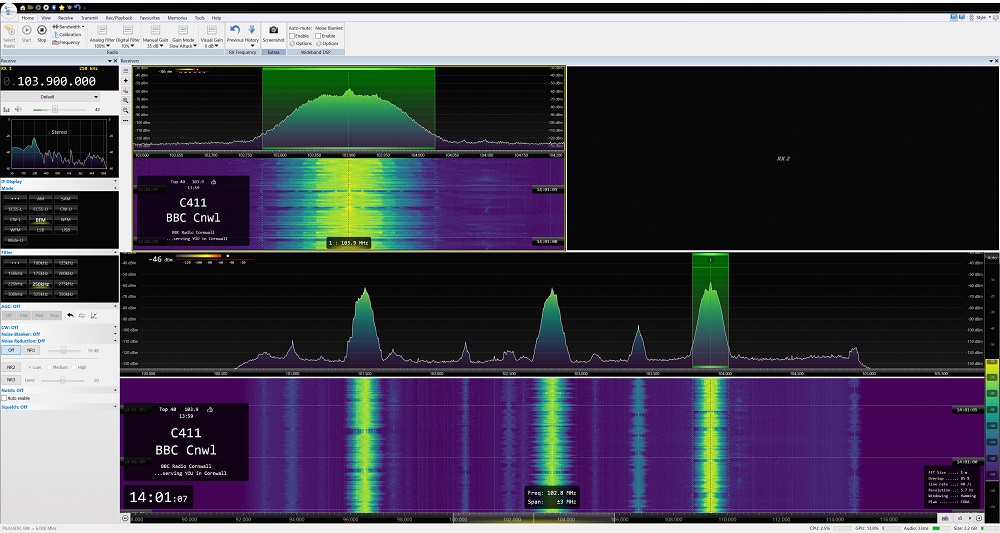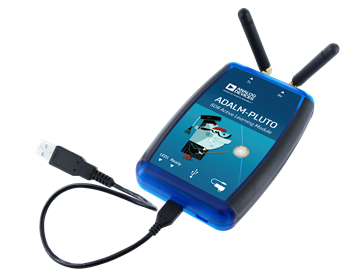
Implementation
Notes
- Analog filter is always enabled.
- When a manual gain is selected the gain mode is switched to manual as well.
- The SDR cannot tune outside the range allocated to the chip – AD9363 or AD9364.
- There’s a hardware ‘hack’ which makes the AD9363 think it’s an AD9364 which has a greated tuning range.
- The digital filter is supported, it’s impressive!
- Multiple devices are supported, the serial number is used when connecting.
This is a very fine SDR, excellent value.
Antennas
Although the API returns a list of available antenna choices for both RX and TX, only one antenna from the lists can be applied. When connecting to a pluto, the RX antenna is set to A_BALANCED and the TX antenna is set to A. If a future revision of the Pluto hardware supports more than one antenna then this logic will be updated.
Attributes
The hardware attributes of the development unit:
hw_model = Analog Devices PlutoSDR Rev.B (Z7010-AD9363)
hw_model_variant = 0
hw_serial = 104473dc59930019edff1100d8cd2918d7
fw_version = v0.29
ad9361-phy,xo_correction = 39999965
ad9361-phy,model = ad9363a
local,kernel = 4.9.0-10475-g2398d50
usb,idVendor = 0456
usb,idProduct = b673
usb,release = 2.0
usb,vendor = Analog Devices Inc.
usb,product = PlutoSDR (ADALM-PLUTO)
usb,serial = 104473dc59930019edff1100d8cd2918d7

Bandwidths
Receive
From the device driver notes the minimum bandwidth is 2.083 MSPS unless FIR Decimation / Interpolation is set, so in this software the lowest bandwidth is 2.1 MHz, the maximum sustained throughput without packet loss is 6MHz.
Transmit
Internally, SDR Console generates the transmit signal (IQ data) with a 192kHz bandwidth. Four stages of x2 upsampling gives a bandwidth of 3.072MHz with a clean signal. As the transmit bandwidth must be the same as the receive bandwidth only 3.072MHz is supported for transmit. At a later date this software can be modified to support transmit on all bandwidths from 2.1 to 6 MHz, but for now only 3.072 MHz is supported.
Gain Control Modes
This text is from Analog Devices [link].
Manual: In MGC mode, the BBP controls the gain index pointer(s). In its simplest form, the BBP evaluates the digital signal level at the I/O port and then adjusts the gain appropriately. The BBP can control manual gain in one of two ways. The default method uses SPI writes (writing in_voltage[0,1]_hardwaregain) the total gain in dB. This results in different gain indices depending on the gain table loaded. Alternatively, the BBP can pulse the Control Input pins to move the gain indices.
Slow attack: Slow Attack Mode is intended for slowly changing signals such as those found in some FDD applications such as WCDMA and FDD LTE. The Slow Attack AGC uses a 2nd order control loop with hysteresis that changes the gain in order to keep the average signal power within a programmable window.
Hybrid: The AGC hybrid mode is the same as the slow AGC mode with the exception that the gain update counter is not used. Instead, gain updates occur when the BBP pulls the CTRL_IN2 signal high. The “hybrid” term arises because the BBP has taken some control of the algorithm away from the AD9361 so gain control is no longer completely automatic.
Fast attack: Fast Attack Mode is intended for waveforms that “burst” on and off, such as those found in TDD applications or GSM/EDGE FDD applications. The AGC responds very quickly to overloads at the start of a burst so that the AGC can settle to an optimum gain index by the time the data portion of the signal arrives.
Transmit
The radio runs in full duplex (receiver runs while transmitting). This is required for transponders such as Es’Hail 2 (a geostationary satellite). There is a menu option RX Mute which is used to disable the waterfall and audio while in transmit mode.
GPIO
Pluto has four general purpose output (GPO) pins. Direct support of these pins is planned.
USB Port
To achieve the maximum sample rate of 6 MSPS (6 MHz bandwidth) a good, powered USB port must be used. USB3 is not necessarily better than USB2; so if there are breaks in the received data try a different USB port. Pluto’s USB is USB 2.0 High-Speed.
Pluto has a second USB connector for additional power – don’t be afraid to use it!
In Action
FM Stereo
Here’s a screenshot of a ‘hacked’ Pluto – the frequency range has been extended to 70 MHz to 6 GHz using the instructions on this page [link].
It’s not quite as good as an Airspy but still very acceptable. The antenna is an 8 element yagi, so probably providing too much input, also picking up two very stong 2.4 GHz Wi-Fi signals.
Meer informatie vind je hier!